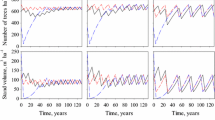Abstract
A special cascading fixed charge structure can be used to characterize a forest management planning problem in which the objectives are to identify the optimal shape of forest harvest cutting units and simultaneously to assign facilities for logging those units. We describe a four-part methodology that has been developed to assist forest managers in analyzing areas proposed for harvesting. This methodology performs an analysis of harvesting feasibility, computes the optimal solution to the cascading fixed charge problem, undertakes a GASP IV simulation to provide additional information about the proposed harvesting operation, and permits the forest manager to perform a time-cost analysis that may lead to a more realistic, and thus improved, solution.
Similar content being viewed by others
Literature cited
Arthur, J. L. 1978. THAS: a timber harvesting analysis system, Volume II: THAS user's manual, rev. ed., Department of Statistics, Oregon State University, Corvallis. 46 pp.
Cohen, C., and J. Stein. 1975. Multi purpose optimization system user's guide, version 2. Manual no. 320, Vogelback Computing Center, Northwestern University, Evanston IL. 131 pp.
Dykstra, D. P. 1976. Timber harvest layout by mathematical and heuristic programming. PhD diss., Oregon State University, Corvallis. 299 pp. Also, no. 76-23510, Xerox University Microfilms, Ann Arbor MI (Diss. Abstracts International 37 (4)).
Dykstra, D. P., and J. L. Riggs. 1977. An application of facilities location theory to the design of forest harvesting areas.AIIE Transactions 9: 270–276.
Feldman, E., F. A. Lehrer, and T. L. Ray. 1966. Warehouse location under continuous economies of scale.Management Science 12:670–684.
Francis, R. L., and J. A. White. 1974.Facility layout and location: an analytical approach. Prentice-Hall, Englewood Cliffs NJ. 468 pp.
Khumawala, B. M. 1971. An efficient heuristic algorithm for the warehouse location problem. Paper no. 311, Herman C. Krannert Graduate School of Industrial Administration, Purdue University, Lafayette IN. 25 pp.
Kuehn, A. A., and M. J. Hamburger. 1963. A heuristic program for locating warehouses.Management Science 9:643–666.
Lemke, C., and K. Spielberg. 1967. Direct search 0-1 and mixed integer programming.Operations Research 15:892–914.
Lussier, L. J. 1961.Planning and control of logging operations. Forest Research Foundation, Laval University, Quebec, 135 pp.
Matthews, D. M. 1942.Cost control in the logging industry. McGraw-Hill, New York. 374 pp.
Peters, P. A. 1978. Spacing of roads and landings to minimize timber harvest cost.Forest Science 24:209–217.
Pritsker, A. A. B. 1974.The GASP IV simulation language. John Wiley & Sons, New York. 451 pp.
Sá, G. 1969. Branch-and-bound and approximate solutions to the capacitated plant-location problem.Operations Research 17:1005–1016.
Shannon, R. E., and J. P. Ignizio. 1970. A heuristic programming algorithm for warehouse locations.AIIE Transactions 2:334–339.
Studier, D. D., and V. W. Binkley. 1974. Cable logging systems. OSU Bookstores, INC., Corvallis OR. 205 pp.
Author information
Authors and Affiliations
Rights and permissions
About this article
Cite this article
Arthur, J.L., Dykstra, D.P. Timber harvest planning—A combined optimization/simulation model. Environmental Management 4, 491–498 (1980). https://doi.org/10.1007/BF01876886
Issue Date:
DOI: https://doi.org/10.1007/BF01876886




